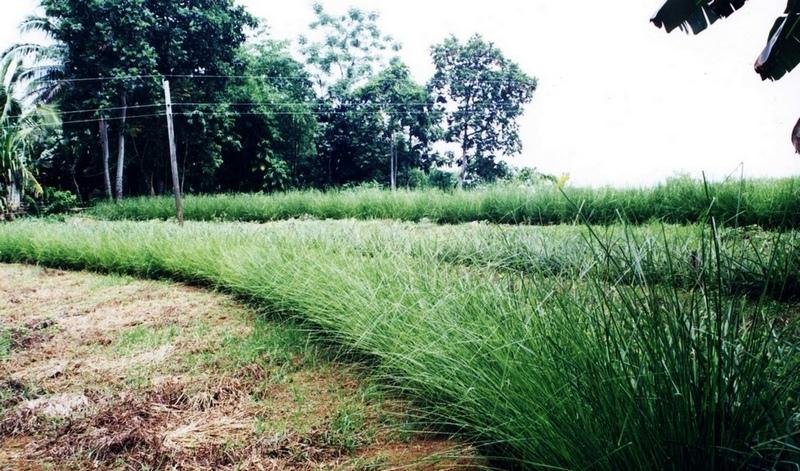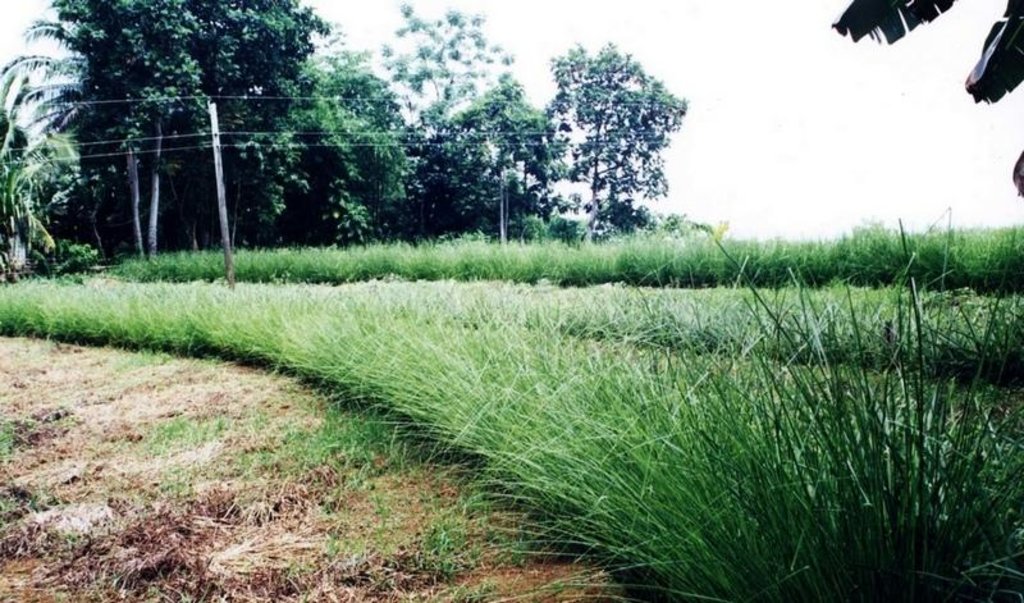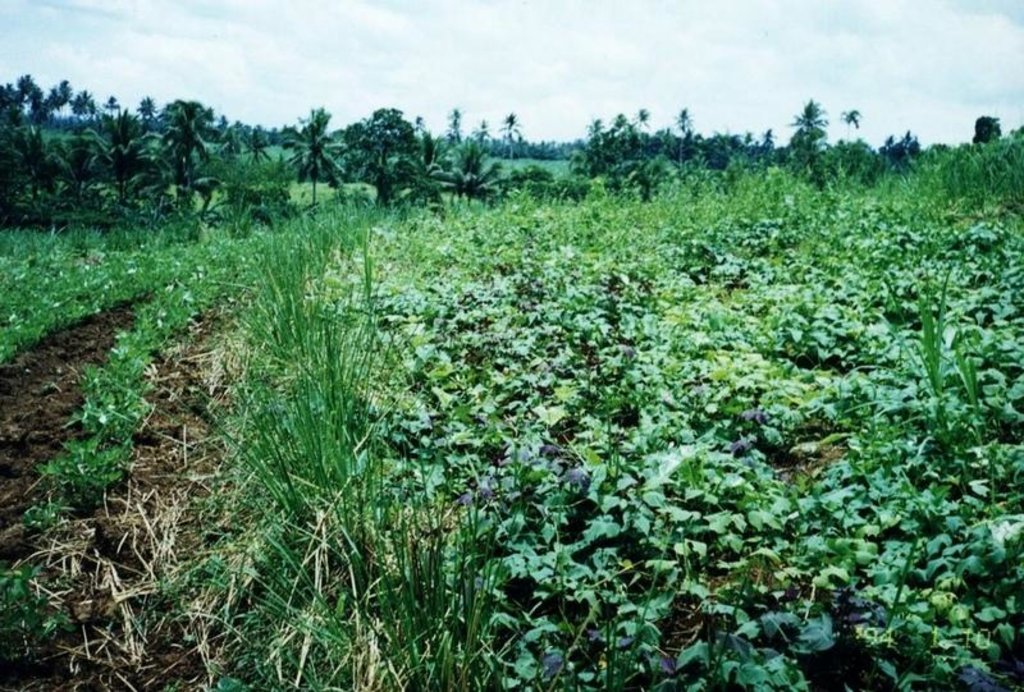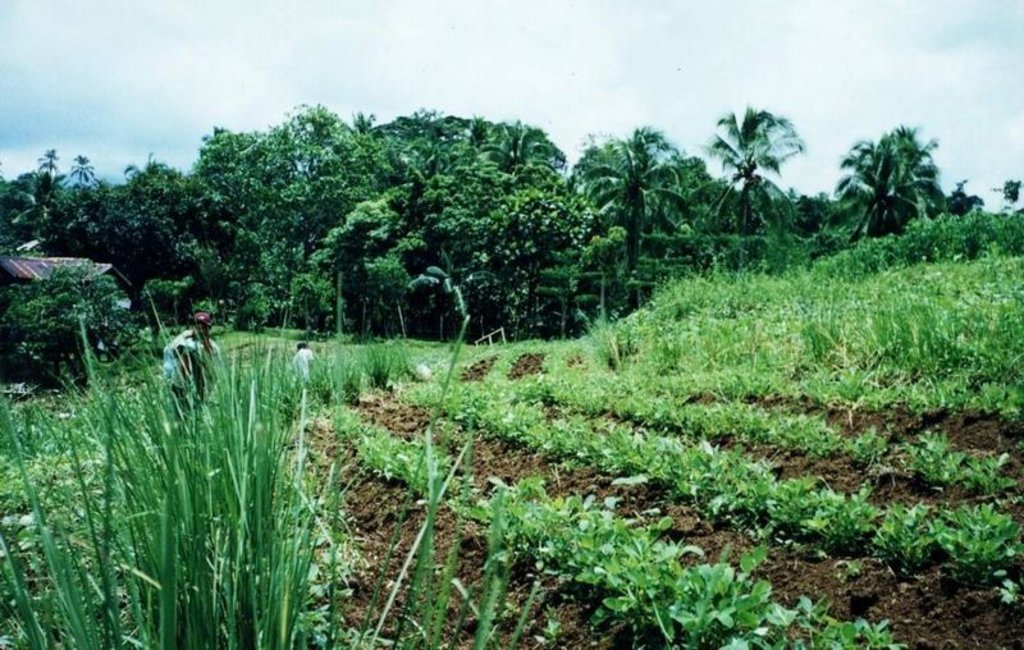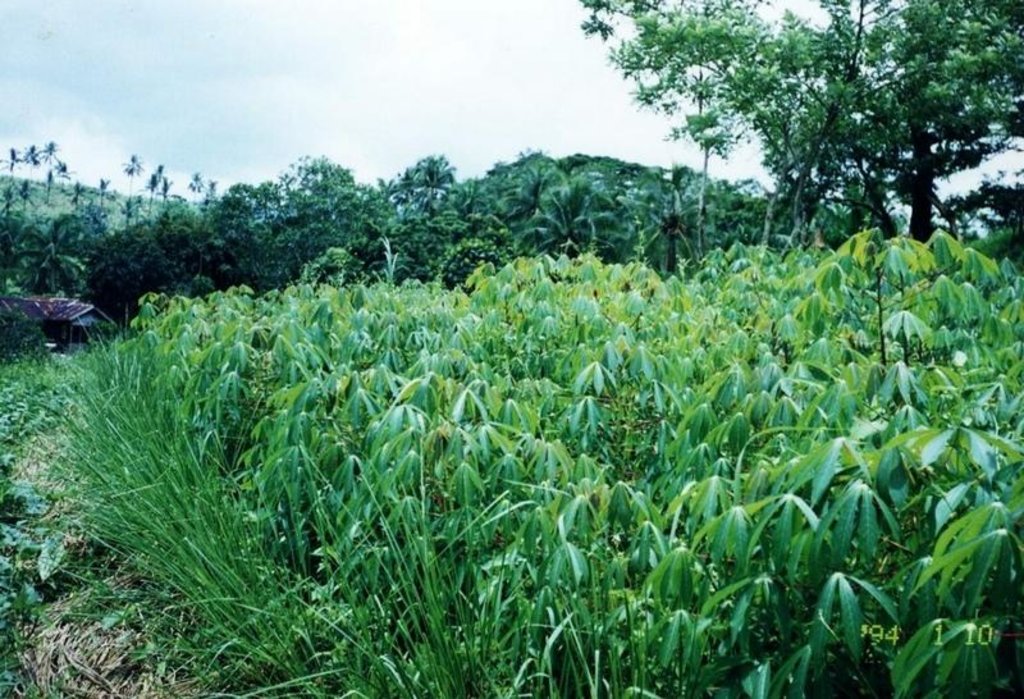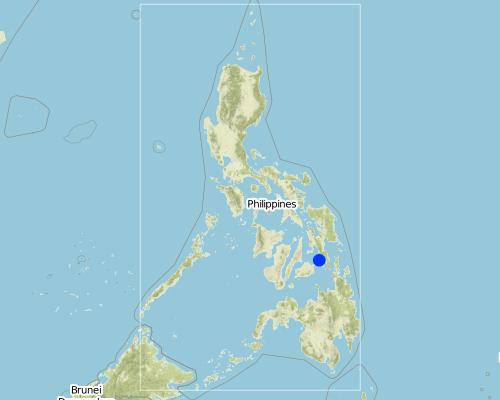Vetiver grass system or Vetiver grass technology [Philippines]
- Creation:
- Update:
- Compiler: Philippine Overview of Conservation Approaches and Technologies
- Editor: –
- Reviewer: Deborah Niggli
Mora, Moras, Amora and Modas in the different regions in the Philippines
technologies_1423 - Philippines
View sections
Expand all Collapse all1. General information
1.2 Contact details of resource persons and institutions involved in the assessment and documentation of the Technology
1.3 Conditions regarding the use of data documented through WOCAT
When were the data compiled (in the field)?
02/08/2002
The compiler and key resource person(s) accept the conditions regarding the use of data documented through WOCAT:
Yes
1.4 Declaration on sustainability of the described Technology
Is the Technology described here problematic with regard to land degradation, so that it cannot be declared a sustainable land management technology?
No
2. Description of the SLM Technology
2.1 Short description of the Technology
Definition of the Technology:
Vetiver grass used as contour hedgerows in sloping agricultural land used for annual crops.
2.2 Detailed description of the Technology
Description:
Vetiver grass is easy to propagate and establish as hedgerow. It is adopted to a wide range of soil and climatic condition. When planted correctly, vetiver grass will form a dense permanent hedge in one year. It has a strong root system that penetrates and binds the soil. Vetiver grass is perennial and requires minimal maintenance. It will not spread to the alleys since it does not multiply by rhizomes nor from seeds. Compare with other grass, it does not compete much with the crops it is protecting. Vetiver crown is below the ground surface which helps protect the plant against fire and overgrazing. Its leaves and roots are resistannt to insects and diseases. Vetiver can withstand, drought, flood and long period of water logging.
2.3 Photos of the Technology
2.5 Country/ region/ locations where the Technology has been applied and which are covered by this assessment
Country:
Philippines
Region/ State/ Province:
Leyte
Further specification of location:
Leyte
Map
×2.6 Date of implementation
If precise year is not known, indicate approximate date:
- more than 50 years ago (traditional)
2.7 Introduction of the Technology
Specify how the Technology was introduced:
- through projects/ external interventions
Comments (type of project, etc.):
As an SWC, the technology is supported and promoted by the World Bank through the Vetiver Network involving several Asian countries.
3. Classification of the SLM Technology
3.1 Main purpose(s) of the Technology
- reduce, prevent, restore land degradation
3.2 Current land use type(s) where the Technology is applied

Cropland
- Annual cropping
Comments:
Major land use problems (compiler’s opinion): Annual cropping of corn and othrer crops in hillyland using plow which makes the soil vulnerable to erosion.
Major land use problems (land users’ perception): Declining productivity and increasing input (fertilizer) to maintain yield.
Type of cropping system and major crops comments: Two crops of corn with legumes. However, not all farmers practice two croppings
3.3 Further information about land use
Water supply for the land on which the Technology is applied:
- rainfed
Number of growing seasons per year:
- 2
Specify:
Longest growing period in days: 110, Longest growing period from month to month: Apr - Dec
3.4 SLM group to which the Technology belongs
- cross-slope measure
3.5 Spread of the Technology
Specify the spread of the Technology:
- evenly spread over an area
If the Technology is evenly spread over an area, indicate approximate area covered:
- 1,000-10,000 km2
Comments:
Total area covered by the SLM Technology is 0.8 m2.
The technology was first used to stabilize/strengthen rice paddy dikes/levees. In the project, the technology is used by small upland farmers to control soil erosion by water.
3.6 SLM measures comprising the Technology

vegetative measures
- V2: Grasses and perennial herbaceous plants
Comments:
Type of vegetative measures: aligned: -contour
3.7 Main types of land degradation addressed by the Technology

soil erosion by water
- Wt: loss of topsoil/ surface erosion
- Wg: gully erosion/ gullying

chemical soil deterioration
- Cn: fertility decline and reduced organic matter content (not caused by erosion)
3.8 Prevention, reduction, or restoration of land degradation
Specify the goal of the Technology with regard to land degradation:
- prevent land degradation
- reduce land degradation
4. Technical specifications, implementation activities, inputs, and costs
4.2 Technical specifications/ explanations of technical drawing
Technical knowledge required for field staff / advisors: moderate
Technical knowledge required for land users: moderate
Main technical functions: control of dispersed runoff: retain / trap, reduction of slope length
Secondary technical functions: control of concentrated runoff: retain / trap
Aligned: -contour
Vegetative material: G : grass
Number of plants per (ha): 10-12 till
Vertical interval between rows / strips / blocks (m): 3
Spacing between rows / strips / blocks (m): 6
Vertical interval within rows / strips / blocks (m): 0.15
Grass species: Vetiver
Slope (which determines the spacing indicated above): 18.00%
If the original slope has changed as a result of the Technology, the slope today is (see figure below): 8.00%
Gradient along the rows / strips: 3.00%
4.3 General information regarding the calculation of inputs and costs
other/ national currency (specify):
Peso
Indicate exchange rate from USD to local currency (if relevant): 1 USD =:
50.0
Indicate average wage cost of hired labour per day:
2.00
4.4 Establishment activities
| Activity | Type of measure | Timing | |
|---|---|---|---|
| 1. | Planting vetiver grass along the contour | Vegetative | Before planting of corn |
| 2. | Replacement/replanting of gaps | Vegetative | land preparation |
4.5 Costs and inputs needed for establishment
| Specify input | Unit | Quantity | Costs per Unit | Total costs per input | % of costs borne by land users | |
|---|---|---|---|---|---|---|
| Labour | labour | ha | 1.0 | 50.0 | 50.0 | 100.0 |
| Plant material | seedlings | ha | 1.0 | 100.0 | 100.0 | 100.0 |
| Total costs for establishment of the Technology | 150.0 | |||||
4.6 Maintenance/ recurrent activities
| Activity | Type of measure | Timing/ frequency | |
|---|---|---|---|
| 1. | pruning | Vegetative | land preparation /once |
4.7 Costs and inputs needed for maintenance/ recurrent activities (per year)
| Specify input | Unit | Quantity | Costs per Unit | Total costs per input | % of costs borne by land users | |
|---|---|---|---|---|---|---|
| Labour | labour | ha | 1.0 | 20.0 | 20.0 | 100.0 |
| Total costs for maintenance of the Technology | 20.0 | |||||
Comments:
Distance of grass strips, distance of planting within strips and frequency of maintenance (trimming).
4.8 Most important factors affecting the costs
Describe the most determinate factors affecting the costs:
Labor is the most important factor (establishing contour, land preparation and planting). Planting materials can be asked for free from other farmers.
5. Natural and human environment
5.1 Climate
Annual rainfall
- < 250 mm
- 251-500 mm
- 501-750 mm
- 751-1,000 mm
- 1,001-1,500 mm
- 1,501-2,000 mm
- 2,001-3,000 mm
- 3,001-4,000 mm
- > 4,000 mm
Agro-climatic zone
- humid
Thermal climate class: tropics
5.2 Topography
Slopes on average:
- flat (0-2%)
- gentle (3-5%)
- moderate (6-10%)
- rolling (11-15%)
- hilly (16-30%)
- steep (31-60%)
- very steep (>60%)
Landforms:
- plateau/plains
- ridges
- mountain slopes
- hill slopes
- footslopes
- valley floors
Altitudinal zone:
- 0-100 m a.s.l.
- 101-500 m a.s.l.
- 501-1,000 m a.s.l.
- 1,001-1,500 m a.s.l.
- 1,501-2,000 m a.s.l.
- 2,001-2,500 m a.s.l.
- 2,501-3,000 m a.s.l.
- 3,001-4,000 m a.s.l.
- > 4,000 m a.s.l.
5.3 Soils
Soil depth on average:
- very shallow (0-20 cm)
- shallow (21-50 cm)
- moderately deep (51-80 cm)
- deep (81-120 cm)
- very deep (> 120 cm)
Soil texture (topsoil):
- medium (loamy, silty)
Topsoil organic matter:
- low (<1%)
5.6 Characteristics of land users applying the Technology
Market orientation of production system:
- subsistence (self-supply)
- mixed (subsistence/ commercial
Off-farm income:
- 10-50% of all income
Relative level of wealth:
- poor
- average
Level of mechanization:
- manual work
- animal traction
Indicate other relevant characteristics of the land users:
Population density: 50-100 persons/km2
Annual population growth: 2% - 3%
30% of the land users are rich and own 10% of the land.
20% of the land users are average wealthy and own 50% of the land.
50% of the land users are poor and own 40% of the land.
Off-farm income specification: Trading, carpentry, hired labour, overseas employment
5.7 Average area of land owned or leased by land users applying the Technology
- < 0.5 ha
- 0.5-1 ha
- 1-2 ha
- 2-5 ha
- 5-15 ha
- 15-50 ha
- 50-100 ha
- 100-500 ha
- 500-1,000 ha
- 1,000-10,000 ha
- > 10,000 ha
5.8 Land ownership, land use rights, and water use rights
Land ownership:
- individual, not titled
- individual, titled
Land use rights:
- individual
6. Impacts and concluding statements
6.1 On-site impacts the Technology has shown
Socio-economic impacts
Production
crop production
land management
Comments/ specify:
hedgerow restricted mobility
Income and costs
workload
Comments/ specify:
during establishment/maintenance
Socio-cultural impacts
SLM/ land degradation knowledge
Comments/ specify:
strong awareness
Ecological impacts
Water cycle/ runoff
surface runoff
Quantity before SLM:
60
Quantity after SLM:
20
Soil
soil moisture
Comments/ specify:
better infiltration
soil loss
Quantity before SLM:
50
Quantity after SLM:
10
Comments/ specify:
almost nil erosion
Other ecological impacts
Soil fertility
Comments/ specify:
increase organic matter
6.2 Off-site impacts the Technology has shown
downstream siltation
Comments/ specify:
almost zero erosion
6.4 Cost-benefit analysis
How do the benefits compare with the establishment costs (from land users’ perspective)?
Short-term returns:
neutral/ balanced
Long-term returns:
positive
How do the benefits compare with the maintenance/ recurrent costs (from land users' perspective)?
Short-term returns:
positive
Long-term returns:
positive
6.5 Adoption of the Technology
Of all those who have adopted the Technology, how many have did so spontaneously, i.e. without receiving any material incentives/ payments?
- 0-10%
Comments:
2% of land user families have adopted the Technology with external material support
5% of land user families have adopted the Technology without any external material support
50 land user families have adopted the Technology without any external material support
There is a moderate trend towards spontaneous adoption of the Technology. Farmers have recognized the benefit of the technology. Even the Local Government Units (LGU's) are supportive of the technology and have adapted it as one of their banner programs.
6.7 Strengths/ advantages/ opportunities of the Technology
| Strengths/ advantages/ opportunities in the land user’s view |
|---|
| Easy to establish and maintain |
| Strengths/ advantages/ opportunities in the compiler’s or other key resource person’s view |
|---|
| Easy to establish and maintain |
| Vetiver grows well even in fertile soil |
6.8 Weaknesses/ disadvantages/ risks of the Technology and ways of overcoming them
| Weaknesses/ disadvantages/ risks in the land user’s view | How can they be overcome? |
|---|---|
| Prevents easier mobility within the farm | Proper farm design |
| Sanctuary for pests | Cleanliness, rat eradication, etc. |
| Weaknesses/ disadvantages/ risks in the compiler’s or other key resource person’s view | How can they be overcome? |
|---|---|
| Prevents easier mobility within the farm | Appropriate farm lay-out |
| Vetiver grass can serve as sanctuary for pests (rats, snakes, etc) | Cleanliness |
7. References and links
7.1 Methods/ sources of information
- field visits, field surveys
- interviews with land users
7.2 References to available publications
Title, author, year, ISBN:
Vetiver for Soil Erosion Control
Available from where? Costs?
Vetiver Network Philippines, Farm and Resource Management Institute, VISCA, Baybay, Leyte, Philippines
Title, author, year, ISBN:
Vetiver Grass the Hedge Against Erosion
Available from where? Costs?
World Bank, Washington D.C., USA
Links and modules
Expand all Collapse allLinks
No links
Modules
No modules


